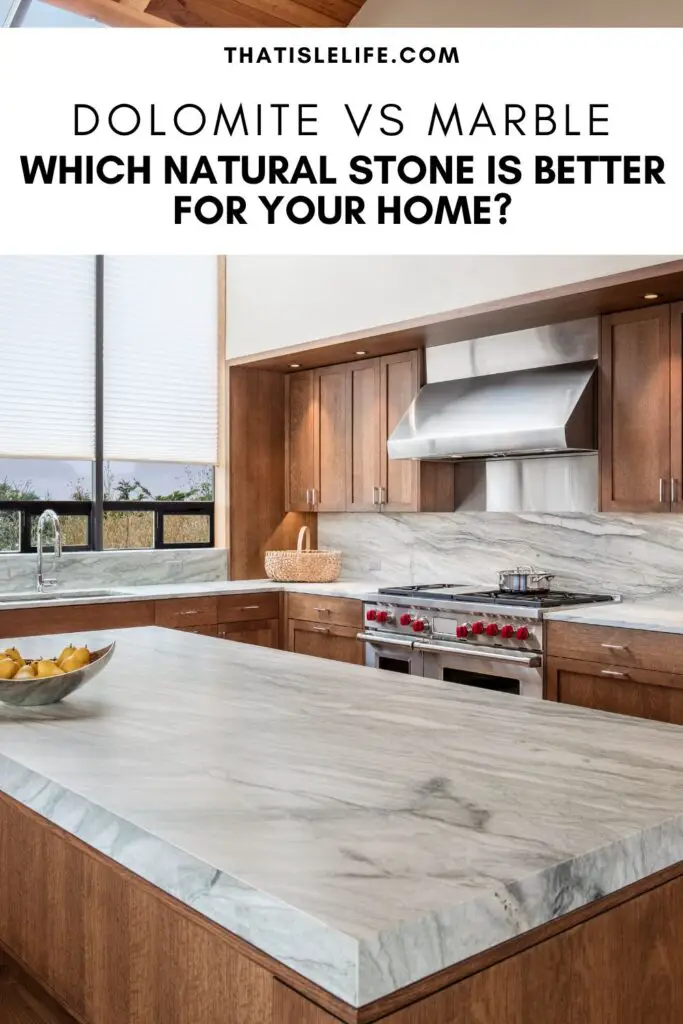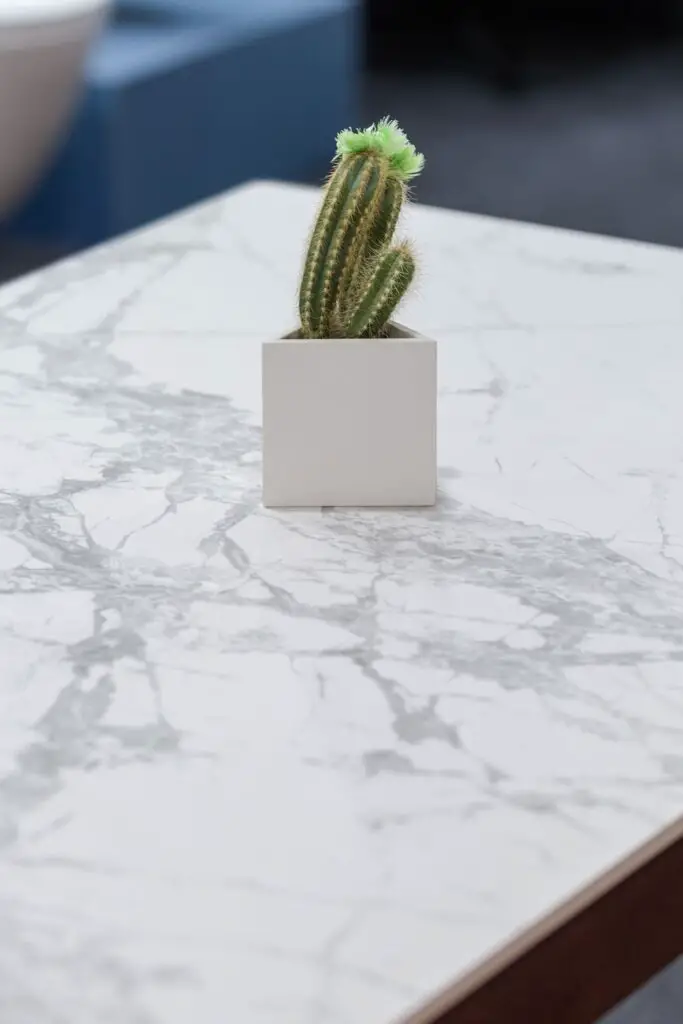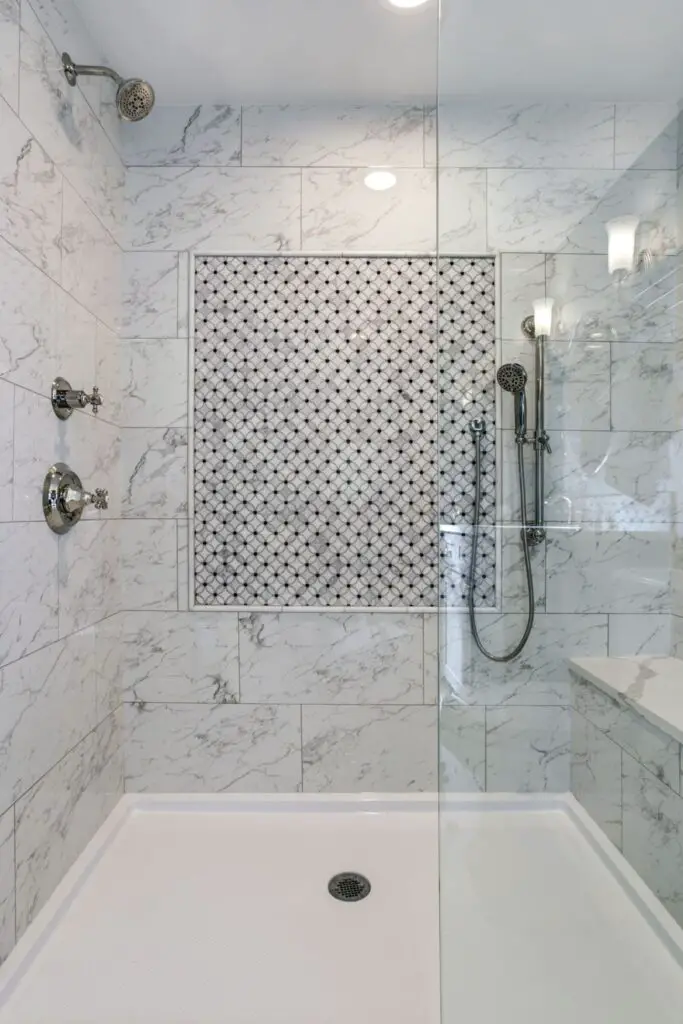Dolomite vs marble – are they the same thing? They may look alike BUT they’re completely different stones! Read on to discover how they differ and which natural stone is better for your home.
Are you renovating your home and looking for a natural stone?
You might be torn between dolomite vs marble, two natural stones that look alike. Or you may have mistaken dolomite for marble at your local stone yard. That’s OK, it happens!
Despite their similarities, there are a few significant differences between the two. It’s important to understand the key differences between dolomite and marble because this can help you to make up your mind!
In this post, I will share everything you need to know about dolomite vs marble – what it is, its composition, its uses, and the pros and cons of each stone.
Read on to discover which natural stone is better for your home.

Related to Dolomite vs Marble:
- Quartz vs Marble – Which is the better option for my kitchen?
- Dolomite vs Granite: Which Is Better For Kitchen Countertops?
- Travertine vs Marble – What’s the difference and which is the better option for my home?
Table of Contents
What is dolomite?

What it is: Dolomite, a sedimentary rock, is formed on the surface of the earth. It is a common stone that can be found in many locations worldwide, especially in the Italian Dolomite Alps.
How it’s made: According to Geology.com, dolomite is formed when the calcite in limestone is modified by the magnesium found in groundwater.
Texture and finish: Smooth to the touch with a high-polished finish
Color: The most common colors are white and grey whereas rare colors include brown, pink, black, and green.
Pattern: Like marble, dolomite has streaks of varied colors or veins running across its surface.
Uses: Kitchen countertops and backsplashes, bathroom countertops, and feature walls
Cleaning instructions: Clean your dolomite countertops daily with a soft cloth, water, and mild water. Wipe dry immediately. Do not use harsh, abrasive, or acidic cleaners, which include lemon juice or vinegar.
Maintenance: As with all natural stones, dolomite requires annual sealing to maintain its quality. Use coasters, trivets, and cutting boards to prevent stains, etch marks, and scratches. Wipe all spills immediately with a soft cloth.
Pros of dolomite
More durable than marble
Both marble and dolomite are porous, which means they’re susceptible to etches, stains, scratches, chips, and cracks. However, dolomite has a Mohs hardness grade of 3.5–4, making it a harder stone than marble. Therefore, it is more durable and will suffer fewer wear and tear marks over the years.
Heat resistant
One of the best things about dolomite is its heat resistance. It retains heat better than many other materials like quartz. While it’s not advisable to place a hot pan directly on any surface, you could probably get away with no burn marks on a dolomite countertop.
Affordable
While there may not be a significant price difference between dolomite and marble, the former is more affordable than the latter. The average price of dolomite is around $55-$75 per square foot, which makes it more affordable than granite, quartz, and quartzite. Prices vary depending on the type of dolomite (e.g. thickness and color) and the location.
Looks beautiful
It’s difficult to tell dolomite and marble apart because they look so similar! Like marble, dolomite has streaks of varied colors or veins across its surface. Its unique pattern and pearly shine make dolomite beautiful and luxurious.
Cons of dolomite
Limited colors available
Most dolomite slabs come in signature grey and white. If you’re looking for a warmer stone, dolomite is probably not for you.
Vulnerable to stains, etches, and scratches
As with most natural stones, dolomite is porous and is still vulnerable to stains, etches, and scratches. Despite being more durable than marble, extra care is recommended to maintain its quality and longevity.
Requires more maintenance
Unlike engineered stones, dolomite needs extra care and maintenance. For instance, dolomite needs to be sealed at least once a year. It is recommended to clean dolomite countertops once a day with a gentle soap as acidic and chemical cleaners may etch or stain the stone. Furthermore, all spills need to be wiped immediately because certain substances like oil, wine, and fruit juices may discolor unsealed dolomite.
What is marble?

What it is: Marble is a metamorphic rock composed primarily of calcite and other minerals like clay minerals, micas, quartz, pyrite, and more.
How it’s made: First, limestone is subjected to the heat and pressure of metamorphism. The calcite in the limestone then goes through a recrystallization process forming marble.
Texture and finish: Smooth to the touch with three common types of finishes – honed, leathered, and polished.
Color: There are many different colors including white, black, green, red/orange, yellow/gold, and brown.
Pattern: Streaks of varied colors or veins running across its surface
Uses: Kitchen countertops, islands, and backsplashes, bathroom countertops, walls, flooring, furniture, and decorative items
Cleaning instructions: Clean your marble countertops daily with a soft cloth, water, and mild water. Wipe dry immediately. Do not use harsh, abrasive, or acidic cleaners, which include lemon juice or vinegar.
Maintenance: As with all natural stones, marble requires regular sealing to maintain its quality. Use coasters, trivets, and cutting boards to prevent stains, etch marks, and scratches. Wipe all spills immediately with a soft cloth.
Pros of Marble
Beautiful, luxurious, and unique
Marble may be high maintenance but many people still love this natural stone because no two slabs are alike. Each piece lends a distinct character to a home with its unique beauty and luxury.
High resale value
Marble typically has a higher resale value compared to dolomite. However, it is important to note that a home’s resale value doesn’t depend entirely on the type of stone used in a home.
Cons of Marble
Vulnerable to stains, etches, and scratches
Marble is extremely porous, making it very vulnerable to stains, etches, and scratches. Extra care is recommended to maintain its quality and longevity.
Expensive
The price of marble varies due to the type of marble (e.g. thickness, grade, color, etc) and location. Generally, marble is more expensive than dolomite, especially rarer marble like Calacatta marble, which can go for $110-$250 per square foot. However, there are more affordable options like Carrara marble, which can go for $40-$100 per square foot.
Requires more maintenance
Just like dolomite, marble needs extra care and maintenance. Marble needs to be sealed regularly to avoid stains and etch marks. Daily cleaning using a gentle soap is recommended as acidic and chemical cleaners may etch or stain the stone. Furthermore, all spills need to be wiped immediately because certain substances like oil, wine, and fruit juices may discolor unsealed marble.
Dolomite vs Marble – which is better for your home?
Are you still confused between both stones? Don’t worry, I got you.
If you don’t have a big budget but still want the look of grey and white marble, dolomite is a great option. In fact, you’ll be getting your money’s worth because it is a stronger stone compared to marble.
However, if you want a different stone color and budget is not a problem, you are better off choosing marble.
Can’t decide which natural or engineered stone to get? Check out these blog posts below:
- Dolomite vs Granite: Which Is Better For Kitchen Countertops?
- Quartz vs Marble – Which is the better option for my kitchen?
- Travertine vs Marble – What’s the difference and which is the better option for my home?
- Terrazzo vs Marble – Which is the better option for your home?
- Sintered stone vs Quartz – Which Slab Is Better For Your Home?

